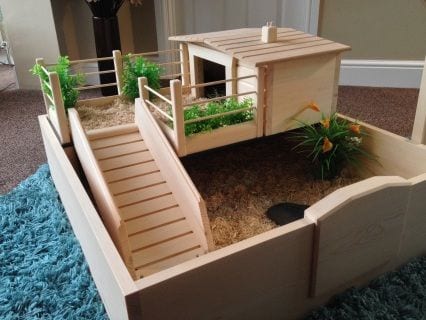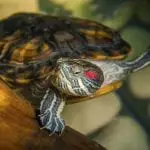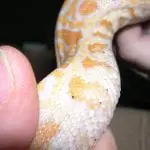Tortoise and turtles should be given a home similar to their natural environment. However, one of the major issues with indoor housing is about giving enough floor space. Most tortoises get pretty big, so you need to provide them with a large enclosure that is easy to clean and allows you to set up various temperature zones. One thing that you should avoid, however, is the use of aquariums.
Glass tanks have poor ventilation and are too small for most turtles. Such tanks are hard to clean as well. Moreover, it’s difficult to provide the right temperature gradient for your pet in a glass tank. If you have a tortoise, you need to make sure that the sides of its enclosure are tall enough that your pet won’t be able to climb over it. Tortoises also prefer a non-transparent enclosure because they probably feel vulnerable and exposed when they are put in a glass-sided tank.
If you want to keep tortoises or turtles indoors, you should consider a wooden enclosure. Tortoise and turtle table houses are large wooden boxes with fairly short sides and a large amount of floor space. Heat lamps and UVA or UVB lighting are usually installed over the table houses to provide heat. You can buy ready-made tortoise and turtle table houses or build it on your own. Here’s what you need to know before building a tortoise and turtle table house.
Water
Tortoises and turtles should have access to clean water at all times. Provide them with water dishes that they can easily get into, drink from, and soak in. The water dishes should be a few inches deep. However, it should not be too deep that your pets cannot stand in it with their head above the water.
Heat
A temperature variation of 70ﹾF to 95ﹾF should be created inside the enclosure. Determine the habitat requirements of your pet. Tortoises and box turtles love basking under heat lamps. You can also increase heat by putting a heating pad underneath the enclosure. A ceramic heater can provide long wave infrared heat during the night without producing any light.
Lighting
You have to make sure that yourtortoises and turtles are getting enough UVB and UVA light to keep them healthy. UVB light promotes Vitamin D synthesis, while UVA improves the appetite of turtles because it makes their food look more natural. You can provide both kinds of light by installing a 2-bulb light fixture 16″ to 18″ above the substrate. Just hang the light fixture from a chain or a board.
One of these is usually enough unless you have a large table. If that’s the case, you need 2 or more light fixtures. Since UVB lights become less efficient as time goes by, you should replace the bulbs every 6 to 9 months if you have fully grown turtles and every 3 months if there are growing turtles in the enclosure. You can use a timer to make things easier for you.
Tropical breeds of tortoise don’t need high-intensity UVB light, and they don’t like bright light. You can give them carrion or prey packed with vitamin D3. You can also use mercury vapor light bulbs. These are good sources of heat as they provide UVB and UVA. If you have a small turtle table, don’t get a powerful light that emits a large amount of heat, as it will be difficult to create temperature variations.
Humidity
Tropical tortoise species and box turtles need an environment with high humidity. The level of humidity inside your house is lower than what tropical tortoise species and box turtles need. To increase the level of humidity inside a turtle table, you have to attach a warm air humidifier to a ventilation tube that goes into the living space of your pet. You can use a timer to have the humidifier work every few hours or run it continuously. The water in the humidifier tank will last longer, so there’s no need to refill it often.
Substrate
You should be able to replace thesubstrate easily when it’s soiled. Soil is not recommended. Ground fir tree bark and coconut fibers are the better options because they absorb moisture well. Sandy soil that remains dry is the ideal choice for tortoises. Seed trays can be used to make substrate sections that are easy to clean and remove.
How to Make Your Own Tortoise and Turtle Table House
Video Credits: Lori’s Hartland
If you have only one turtle, you can make a 4 ft sq enclosure. In case you have three turtles, it’s best that you build a 4′ x 8′ enclosure. For the base of the table house, you need a 3/4″ thick plywood sheet in those sizes. You also need the following materials:
- A sheet of plexiglass (at least 3/16″ thick and between 16″ and 20″ high)
- Four 8′ long 2-by-4s for support
- 5 trays of different depths (should have edges and not exceed 4″). These will be the plant, water, and dirt trays. If you need a deeper tray, you can use a medium-sized cat litter tray.
- Plexiglass cutter
- Sandpaper
- 1 tube aquarium sealant
- 1/2 gallon polyurethane sealer
- Wood screws (flat-topped)
- Nails
- Hammer
- Jigsaw
- Substrate
- Power drill w/ bits
- Full-spectrum UV lights
- Plants
1. Create the Base
The base will be the plywood, and the trays will serve as the attractions for the turtles. Provide them with clean water in a shallow tray. You can put dirt in a deep tray. Put the trays at one end of the plywood. Use the jigsaw to make holes in the same plywood.
If you’re using trays with edges and you didn’t cut a lot, the trays will remain suspended without construction. Put the remaining trays on the opposite side. One tray should be near the middle, and the other two should be at the far end. Sand the edges of the plywood and apply the sealer. Sand it gently once it dries.
2. Make the Frame
Put the longboards along the perimeter of the base then screw them into place. Apply a drop of polyurethane sealer over the screws to prevent loss of moisture during use. Cut 2 of the boards in half. Two out of the 4 pieces of the board will be used for interior framing, and the other 2 will be used as the shorter sides.
Make sure that these boards are not in the way of the holes for the trays. Screw the boards into place. The frame should be flushed along the edges of the plywood. Place the framed base on a sturdy surface.
3. Plexiglass Siding
The plexiglass siding will enclose the table house. Put the siding along the base and frame of the enclosure. Create hole marks for screws 1 ½ and 3″ from the base of the frame and create these marks every 2′ on all sides. Screw the plexiglass sheets into the bottom of the frame slowly and gently. Don’t go too fast, or the plexiglass sheets will crack. Seal the plexiglass-plywood and plexiglass-plexiglass joints with the aquarium sealant. Let the sealant dry completely.
Once you have sealed up everything, you can put the enclosure on a low table or low bookshelf that can support its weight. Put the trays in the holes and seal them. There should be leafy plants that your turtles can use for eating or for cover. Pour the right substrate and dirt mixture for your pet into the deep trays.
You should also put hollowed-out half logs within the enclosure that the turtles can use as hiding spots. Spread a thin substrate layer all over the base. Install and turn the lights on, fill the water trays, and put the turtles inside the enclosure.
4. Decorate the Table House
You can make the enclosure aesthetically pleasing by staining the sides of the base and the frame with colors that match your home’s décor. You can also use synthetic or wooden siding materials that you can attach in strips so that you can hide the plexiglass part that is fastened to the frame as well as the division between the frame and the base.
What If You Don’t Know How to Build One?

If you don’t know how to build a table house or you just can’t be bothered to make one, you can use bookshelves on its back instead. Shelves can serve as a lighting prop or as dividers. Since the walls of most bookshelves are quite low, you will probably need some kind of overhang or top.
You can also find ready-made table-style enclosures out there. These enclosures are made from solid wood and can be used indoors and outdoors. The best thing about these table-style enclosures is that they can be dismantled. They have shaded and basking areas, detachable side panels and floor, and open-bottom part for grazing.
Don’t just focus on the aesthetic appeal of the enclosure. You have to make sure that it is easy to clean and maintain. It is difficult to keep complex enclosures clean. If you’re able to find the perfect enclosure for your tortoise or turtle, you will definitely enjoy taking care of your pet and keeping his environment clean and healthy.


